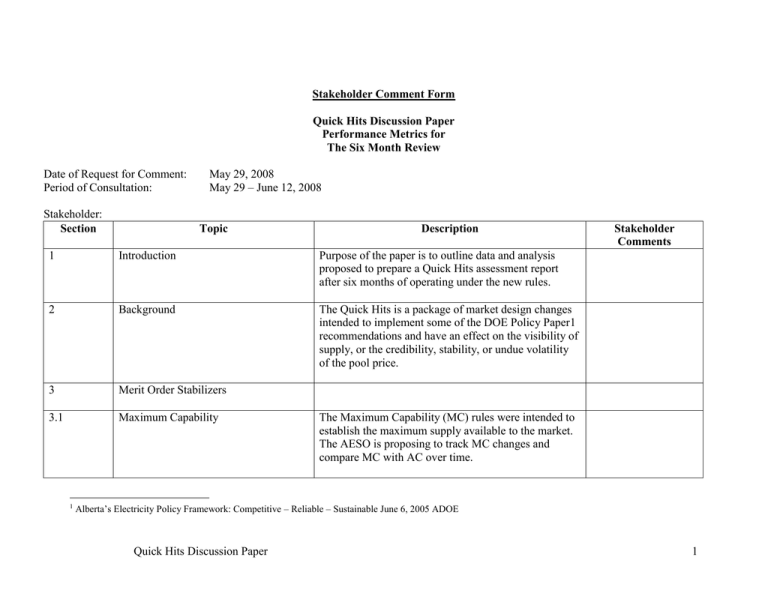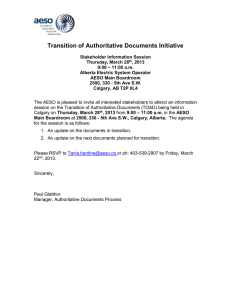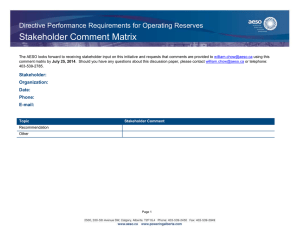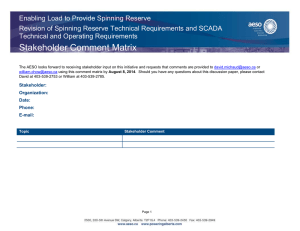Date of Request for Comment: May 29, 2008 Period of Consultation:
advertisement

Stakeholder Comment Form Quick Hits Discussion Paper Performance Metrics for The Six Month Review Date of Request for Comment: Period of Consultation: Stakeholder: Section May 29, 2008 May 29 – June 12, 2008 Topic Description 1 Introduction Purpose of the paper is to outline data and analysis proposed to prepare a Quick Hits assessment report after six months of operating under the new rules. 2 Background The Quick Hits is a package of market design changes intended to implement some of the DOE Policy Paper1 recommendations and have an effect on the visibility of supply, or the credibility, stability, or undue volatility of the pool price. 3 Merit Order Stabilizers 3.1 Maximum Capability 1 Stakeholder Comments The Maximum Capability (MC) rules were intended to establish the maximum supply available to the market. The AESO is proposing to track MC changes and compare MC with AC over time. Alberta’s Electricity Policy Framework: Competitive – Reliable – Sustainable June 6, 2005 ADOE Quick Hits Discussion Paper 1 3.2 Available Capability The Available Capability (AC) rules were intended to help establish on a hour by hour basis the actual supply available to the market. The AESO is proposing to monitor AC trends and compare AC to TDE (under previous rules). 3.3 Energy Restatements and Acceptable Operating Reasons (AOR) Mandatory Energy Restatement (MER) rules were created to facilitate ongoing supply updates. The AESO is proposing to monitor restatement trends as well as the AOR’s for MER’s. Comparisons to pre Quick Hits restatement activity will also be made. 3.4 Voluntary Price Restatements Voluntary Price Restatements (VOR) were introduced to provide the market additional restatement flexibility prior to T-2. The AESO proposes to monitor VOR trends and make comparisons to the pre Quick Hits activity. 3.5 Offer Behavior and Pool Prices The AESO intends to monitor the merit order to determine if offer behavior has changed compared to historical behavior and whether the resultant merit order appears more or less stable. 4 Transmission Must Run and Dispatch Down Service To address the unintended consequences of Transmission Must Run (TMR) dispatches on the pool price, Dispatch Down Service (DDS) rules were created to establish a market for generators to offer a price to voluntarily dispatch down and offset the impact of a TMR dispatch. An analysis of the DDS market will be undertaken. Quick Hits Discussion Paper 2 5 Payments to Suppliers on the Margin The new rules regarding payments to suppliers on the margin (PSM) were intended to give generators a better opportunity to receive payments based on their actual offer price and encourage dispatch compliance. The AESO currently has detailed PSM reporting available on its website and will utilize that information in its report. 6 Treatment of Imports and Exports The Quick Hit rules and protocols are intended to treat importers and intra-Alberta generators as consistently as possible given the operating procedures of other control areas. The AESO is proposing to monitor the impact of the Quick Hits rules on imports and exports. 7 Adequacy and Price Forecasting The AESO will evaluate the effectiveness of the adequacy assessments and the two hour price forecasts. 7.1 Adequacy Assessment A new adequacy assessment report was created to 10 improve the information available to the market by providing daily and weekly assessments which indicate the amount by which supply exceeds demand on an hourly basis. 7.2 Two Hour Pool Price Forecast Existing AESO reports were modified to provide pool price forecasts for the next two settlement hours and to update those forecasts as supply conditions change. 8 Congruence With Government Policy The Quick Hits Metrics are intended to reaffirm that the Quick Hits rules are aligned with the DOE policy intent. Quick Hits Discussion Paper 3 9 Next Steps Appendix 1 A) Quick Hits Metrics Summary Tables Merit Order Stabilizers- Must Offer and Restatements B) TMR and DDS The summary table highlights the DDS metrics being proposed and illustrates the various categories and time trend analysis that are being contemplated. C) Payments to Suppliers on the Margin The summary table highlights the PSM metrics being proposed and illustrates the various categories, time periods and time trend analysis that are being contemplated. D) Treatment of Imports and Exports The summary table highlights the import / export metrics being proposed and illustrates the various categories, time periods and time trend analysis that are being contemplated. E) Adequacy and Price Forecasting The summary table highlights the pool price metrics being proposed and illustrates the various time periods and time trend analysis that are being contemplated. Quick Hits Discussion Paper After receiving feedback from stakeholders, the AESO will review the feedback and respond to comments, suggestions and concerns. The AESO will use the feedback to continue developing the metrics and will use the metrics to monitor the market on an ongoing basis. The summary tables highlight the Merit Order Stabilizer metrics being proposed and illustrate the various categories, time periods and time trend analysis that are being contemplated. 4 Additional Comments Additional comments that supplement the feedback being provided are welcomed. Stakeholder Comment Form Quick Hits Discussion Paper 5



